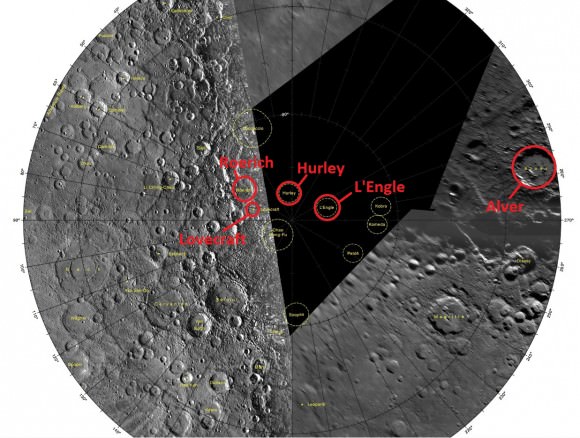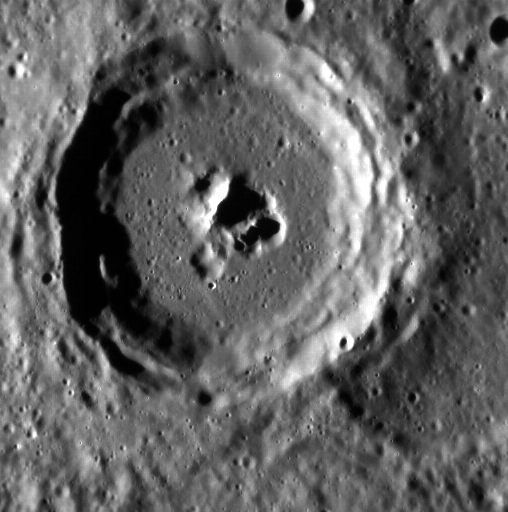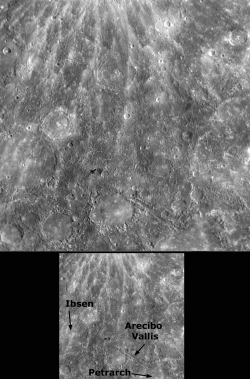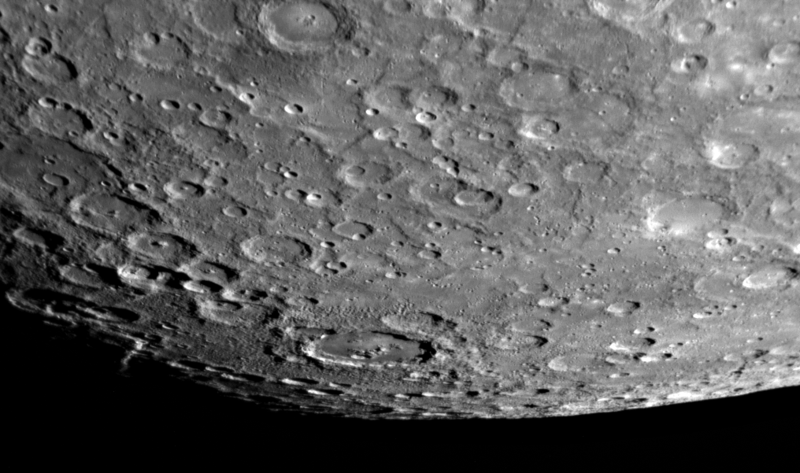Move over, Tolkien & Tryggvadóttir. Yesterday, an announcement was made that the International Astronomical Union (IAU) approved proposed names for nine new craters on the planet Mercury. The names honor deceased writers, artists and musicians following the convention established by the IAU for naming features on the innermost world.
The announcement comes as NASA’s MESSENGER spacecraft has completed mapping of the surface of Mercury earlier this month. A good majority of these features were established at Mercury’s southern polar region, one of the last areas of the planet to be mapped by MESSENGER.
The craters honored with a newly assigned moniker are:
Donelaitis, named after 18th century Lithuanian poet Kristijonas Donelaitis, author of The Seasons and other tales and fables.
Petofi, named after 19th century Hungarian poet Sandor Petofi, who wrote Nemzeti dal which inspired the Hungarian Revolution of 1848.
Roerich, named after early 20th century Russian philosopher and artist Nicholas Roerich, who created the Roerich Pact of 1935 which asserted the neutrality of scientific, cultural and educational institutions during time of war.
Hurley, named after the 20th century Australian photographer James Francis Hurley, who traveled to Antarctica and served with Australian forces in both World Wars.
Lovecraft, named after 20th century American author H.P. Lovecraft, a pioneer in horror, fantasy and science fiction.
Alver, named after 20th century Estonian author Betti Alver who wrote the 1927 novel Mistress in the Wind.
Flaiano, named after 20th century Italian novelist and screenwriter Ennio Flaiano who was a pioneer Italian cinema and contemporary of Federico Fellini.
Pahinui, named after mid-20th century Hawaiian musician Charles Phillip Kahahawai Pahinui, influential slack-key guitar player and part of the “Hawaiian Renaissance” of island culture in the 1970’s.
L’Engle, named after American author Madeleine L’Engle, who wrote the young adult novels An Acceptable Time, A Swiftly Tilting Planet & A Wind in the Door. L’Engle passed away in 2007.

The nine new crater names join 95 others named thus far. The MESSENGER surface mapping campaign has been ongoing since the spacecraft’s first flyby of Mercury in January 2008. MESSENGER entered permanent orbit around world on March 18th, 2011.
MESSENGER missions operations engineer Ray Espiritu was instrumental in getting Pahinui’s name in the running.
“I wanted to honor the place where I grew up and still call home,” Espiritu said. ”The Pahinui crater contains a possible volcanic vent, and its name may inspire other scientists as they investigate the volcanic processes that helped to create Mercury, just as investigation of the Hawaiian volcanoes helps us understand the volcanic processes that shape Earth as we know it today.”

Lovecraft is another interesting selection on the list. The name of the famous horror writer was in the running last month for the naming of Pluto’s moons P4 & P5, and New Horizons principle investigator Alan Stern hinted that Lovecraft may still find a home on a surface feature as New Horizons reveals Pluto & Charon in July 2015. It would be a fitting tribute to a fine writer. Could we end up with Lovecraft marking not only the solar system’s “hubs of hell” on Mercury, but its frozen outer wastelands as well?
There was more news yesterday in the realm of astrogeology and the planet Mercury. The IAU Working Group for Planetary System Nomenclature also made the distinction between features described as valles and catenae on the surface of Mercury. Catenae are described as crater chains, and MESSENGER has sufficient resolution that several valles have been revealed as such. Catenae on Mercury are named after radio astronomy observatories, while valles are named after abandoned cities of antiquity. Thus, Haystack Vallis is now Haystack Catena, Goldstone Vallis is now Goldstone Catena, and Arecibo Vallis is now Arecibo Catena, and, well, you get the idea.

MESSENGER has proven to be a boon for planetary science. The spacecraft was launched in 2004 and took almost 7 years and 6 flyby assists (one past the Earth, two past Venus and three past Mercury) to become the first spacecraft to orbit the tiniest planet in our solar system. Mercury was first seen up close by Mariner 10 in 1974 and even then we only mapped 45% of its surface. Scientists had to wait until MESSENGER to fill in the remainder of Mercury’s map.
The next mission to Mercury isn’t until the planned arrival of the joint ESA/JAXA BepiColombo mission in 2022.
And don’t forget to watch for Mercury as it reaches greatest elongation on Easter Day low in the dawn sky. I managed to catch sight of it low to the east with binoculars for the first time this apparition this morning about 40 minutes prior to local sunrise. It’s amazing to think that ground-based professional telescopes & even amateur astronomers can actually image fuzzy details on the planet’s surface that match up with what MESSENGER is revealing!
All fascinating stuff to contemplate as we welcome the newest named craters to our ever expanding map of Mercury… now, will there ever be a Miskatonic University within the walls of Lovecraft crater?
-Explore these recently named craters and more using the USGS inactive Astrogeology Science Center.
-Also check out this animation of the south polar region of Mercury and more as imaged by MESSENGER.

